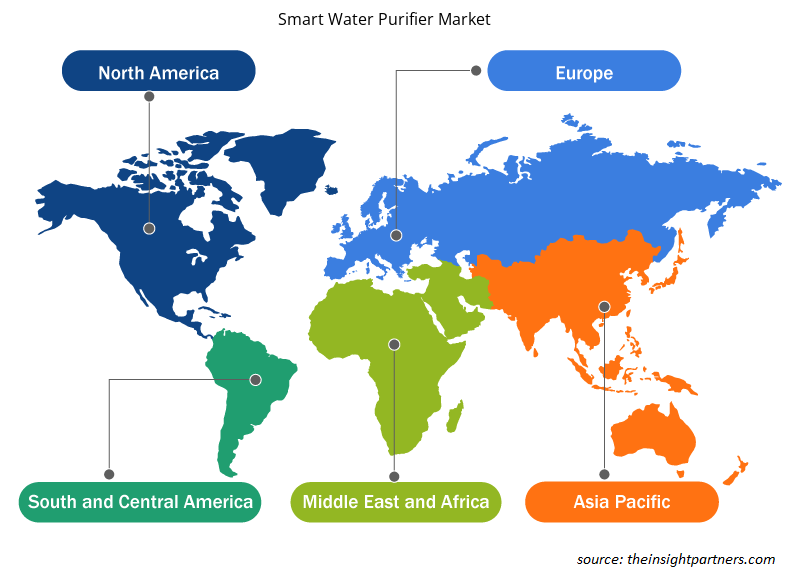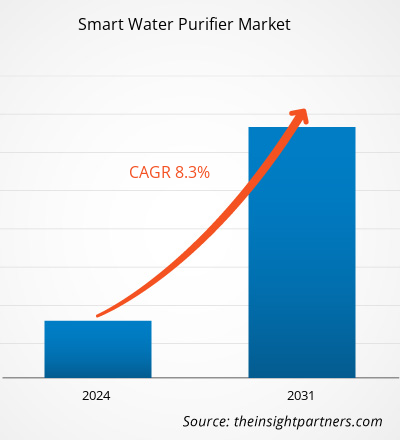스마트 정수기 시장 규모는 2023년 18억 9,000만 달러에서 2031년 35억 8,000만 달러로 성장할 것으로 예상됩니다. 이 시장은 2023~2031년 동안 8.3%의 CAGR을 기록할 것으로 예상됩니다. 수인성 질병에 대한 인식 증가와 기술의 새로운 발전은 시장의 주요 트렌드이자 원동력이 될 가능성이 높습니다.
스마트 정수기 시장 분석
스마트 정수기 시장은 전 세계적으로 상당한 성장을 경험하고 있습니다. 이러한 성장은 수인성 질병에 대한 인식 증가와 기술의 새로운 발전에 기인합니다. 게다가 개발도상국의 스마트 정수기 수요 증가와 더 나은 맛과 건강을 위한 재광화는 향후 몇 년 동안 시장 성장을 견인할 것으로 예상됩니다.
스마트 정수기 시장 개요
가정용 스마트 정수기는 물에서 불순물을 제거하기 위해 고급 여과 기술을 사용합니다. 일반적으로 역삼투(RO), 활성탄 및 기타 고급 필터를 조합하여 박테리아, 바이러스, 화학 물질 및 중금속과 같은 불순물을 제거합니다.
귀하의 요구 사항에 맞게 이 보고서를 사용자 정의하세요
이 보고서의 일부 또는 국가 수준 분석, Excel 데이터 팩을 포함하여 모든 보고서에 대한 사용자 정의를 무료로 받을 수 있으며 신생 기업 및 대학을 위한 훌륭한 혜택과 할인 혜택을 이용할 수 있습니다.
- 이 보고서의 주요 시장 동향을 알아보세요.이 무료 샘플에는 시장 동향부터 추정 및 예측까지 다양한 데이터 분석이 포함됩니다.
스마트 정수기 시장 동인 및 기회
물에서 전파되는 질병에 대한 인식을 높여 시장을 활성화
수인성 질병에 대한 인식 증가는 실제로 스마트 정수기 시장을 주도하고 있습니다. 오염으로 인해 수인성 질병의 수가 증가하고 있으며 스마트 정수기에 대한 필요성도 커지고 있습니다. 오염된 물과 열악한 위생 시설은 콜레라, 설사, 이질, A형 간염, 장티푸스 및 소아마비와 같은 질병의 전파와 관련이 있습니다. 수인성 질병의 성장을 극복하기 위해 많은 기업이 역삼투 스마트 정수기, UV(자외선) 스마트 정수기 및 UF(초여과) 스마트 정수기와 같은 정수 시스템에 투자하고 있습니다. 따라서 위의 매개변수를 고려할 때 수인성 질병에 대한 인식 증가가 시장 성장을 주도하고 있습니다.
개발도상국에서 스마트 정수기 수요 증가.
개발도상국에서 스마트 정수기에 대한 수요가 증가함에 따라 스마트 정수기 시장에 여러 기회가 생길 것으로 예상됩니다. 깨끗한 물 소비, 산업화 및 도시화, 산업화의 이점에 대한 인식 증가, 정부 이니셔티브 및 캠페인이 글로벌 시장을 주도하고 있습니다. 또한, 특히 개발도상국에서 수인성 질병이 증가함에 따라 시장 성장이 더욱 촉진되고 있습니다. 개발도상국에서 도시화가 확대됨에 따라 스마트 정수기에 대한 수요도 증가하고 있습니다. 따라서 위의 매개변수로 인해 개발도상국의 스마트 정수기에 대한 수요는 시장에서 여러 기회가 생길 것으로 예상됩니다.
스마트 정수기 시장 보고서 세분화 분석
스마트 정수기 시장 분석에 기여한 주요 세그먼트는 연결성, 기술, 최종 사용자 및 판매 채널입니다.
- 연결성을 기준으로 스마트 정수기 시장은 Wi-Fi, 블루투스, 스마트 앱으로 구분됩니다. Wi-Fi 세그먼트는 예측 기간 동안 상당한 시장 점유율을 차지할 것으로 예상됩니다.
- 기술에 따라 스마트 정수기 시장은 초여과(UF), 자외선(UV), 역삼투, 다단계 정수기 등으로 구분됩니다. 초여과(UF) 부문은 예측 기간 동안 상당한 시장 점유율을 차지할 것으로 예상됩니다.
- 최종 사용자별로 시장은 주거용, 상업용, 산업용, 판매 채널(소매점, 직접 판매, 온라인)로 세분화됩니다. 주거용 세그먼트는 예측 기간 동안 상당한 시장 점유율을 차지할 것으로 예상됩니다.
- 판매 채널별로 시장은 소매점, 직접 판매, 온라인으로 세분화됩니다. 소매점 세그먼트는 예측 기간 동안 상당한 시장 점유율을 차지할 것으로 예상됩니다.
지역별 스마트 정수기 시장 점유율 분석
스마트 정수기 시장 보고서의 지리적 범위는 주로 북미, 아시아 태평양, 유럽, 중동 및 아프리카, 남중부 아메리카의 5개 지역으로 나뉩니다.
북미는 스마트 정수기 시장을 지배해 왔습니다. 북미 지역의 다양한 산업에서 첨단 기술 도입 추세가 스마트 정수기 성장을 촉진했습니다. 수인성 질병에 대한 인식이 높아지고 이 지역에서 기술이 발전하고 있습니다. 또한 디지털 도구 도입이 증가하고 정부 기관에서 높은 기술 지출을 하는 것과 같은 요인이 북미 스마트 정수기 시장 성장을 견인할 것으로 예상됩니다. 게다가 미국과 캐나다의 선진 경제권에서 연구 개발에 중점을 두면서 북미 업체는 기술적으로 진보된 솔루션을 시장에 내놓을 수밖에 없습니다. 게다가 미국에는 혁신적인 솔루션 개발에 점점 더 주력하고 있는 많은 엔지니어링 소프트웨어 시장 업체가 있습니다. 이러한 모든 요인이 이 지역의 스마트 정수기 시장 성장에 기여합니다.
스마트 정수기 시장 지역별 통찰력
Insight Partners의 분석가들은 예측 기간 동안 스마트 정수기 시장에 영향을 미치는 지역적 추세와 요인을 철저히 설명했습니다. 이 섹션에서는 북미, 유럽, 아시아 태평양, 중동 및 아프리카, 남미 및 중미의 스마트 정수기 시장 세그먼트와 지리에 대해서도 설명합니다.

- 스마트 정수기 시장에 대한 지역별 데이터 얻기
스마트 정수기 시장 보고서 범위
| 보고서 속성 | 세부 |
|---|---|
| 2023년 시장 규모 | 18억 9천만 달러 |
| 2031년까지 시장 규모 | 35억 8천만 달러 |
| 글로벌 CAGR (2023-2031) | 8.3% |
| 역사적 데이터 | 2021-2022 |
| 예측 기간 | 2024-2031 |
| 다루는 세그먼트 | 연결성별
|
| 포함된 지역 및 국가 | 북아메리카
|
| 시장 선도 기업 및 주요 회사 프로필 |
|
스마트 정수기 시장 참여자 밀도: 비즈니스 역학에 미치는 영향 이해
스마트 정수기 시장은 소비자 선호도의 변화, 기술 발전, 제품의 이점에 대한 인식 증가와 같은 요인으로 인해 최종 사용자 수요가 증가함에 따라 빠르게 성장하고 있습니다. 수요가 증가함에 따라 기업은 제품을 확장하고, 소비자의 요구를 충족하기 위해 혁신하고, 새로운 트렌드를 활용하여 시장 성장을 더욱 촉진하고 있습니다.
시장 참여자 밀도는 특정 시장이나 산업 내에서 운영되는 회사나 기업의 분포를 말합니다. 주어진 시장 공간에 얼마나 많은 경쟁자(시장 참여자)가 존재하는지 그 규모나 총 시장 가치에 비해 나타냅니다.
스마트 정수기 시장에서 활동하는 주요 기업은 다음과 같습니다.
- 버진 퓨어
- 3M
- AO 스미스 워터 테크놀로지
- LG전자
- 리브퓨어 스마트 홈 프라이빗 리미티드
- 멤브레인 솔루션 LLC
면책 조항 : 위에 나열된 회사는 어떤 특별한 순서에 따라 순위가 매겨지지 않았습니다.

- 스마트 정수기 시장 주요 업체 개요 알아보기
스마트 정수기 시장 뉴스 및 최근 개발
스마트 정수기 시장은 1차 및 2차 조사 이후의 정성적, 정량적 데이터를 수집하여 평가합니다. 여기에는 중요한 기업 간행물, 협회 데이터 및 데이터베이스가 포함됩니다. 스마트 정수기 시장의 몇 가지 개발 사항은 다음과 같습니다.
- 아시아 최고의 홈 서비스 플랫폼 중 하나인 Urban Company가 하위 브랜드 Native로 새로운 스마트 RO 정수기 제품군을 출시했습니다. Native M1 및 M2 모델은 최첨단 기술과 차별화된 고품질 필터를 장착하여 가정에 깨끗하고 안전한 식수를 제공하도록 설계되었습니다. (출처: Urban Company 웹사이트, 2023년 10월)
스마트 정수기 시장 보고서 범위 및 제공물
"스마트 정수기 시장 규모 및 예측(2021-2031)" 보고서는 아래 영역을 포괄하는 시장에 대한 자세한 분석을 제공합니다.
- 범위에 포함된 모든 주요 시장 세그먼트에 대한 글로벌, 지역 및 국가 수준의 스마트 정수기 시장 규모 및 예측
- 스마트 정수기 시장 동향 및 동인, 제약, 주요 기회와 같은 시장 역학
- 자세한 PEST/포터의 5가지 힘과 SWOT 분석
- 주요 시장 동향, 글로벌 및 지역 프레임워크, 주요 업체, 규정 및 최근 시장 개발 사항을 포괄하는 스마트 정수기 시장 분석
- 시장 집중도, 히트맵 분석, 유명 업체, 스마트 정수기 시장의 최근 동향을 다루는 산업 환경 및 경쟁 분석
- 자세한 회사 프로필
- 과거 분석(2년), 기준 연도, CAGR을 포함한 예측(7년)
- PEST 및 SWOT 분석
- 시장 규모 가치/거래량 - 글로벌, 지역, 국가
- 산업 및 경쟁 환경
- Excel 데이터세트
최근 보고서
관련 보고서
사용 후기
구매 이유
- 정보에 기반한 의사 결정
- 시장 역학 이해
- 경쟁 분석
- 고객 인사이트
- 시장 예측
- 위험 완화
- 전략 기획
- 투자 타당성 분석
- 신흥 시장 파악
- 마케팅 전략 강화
- 운영 효율성 향상
- 규제 동향에 발맞춰 대응





















 무료 샘플 받기 - 스마트 정수기 시장
무료 샘플 받기 - 스마트 정수기 시장